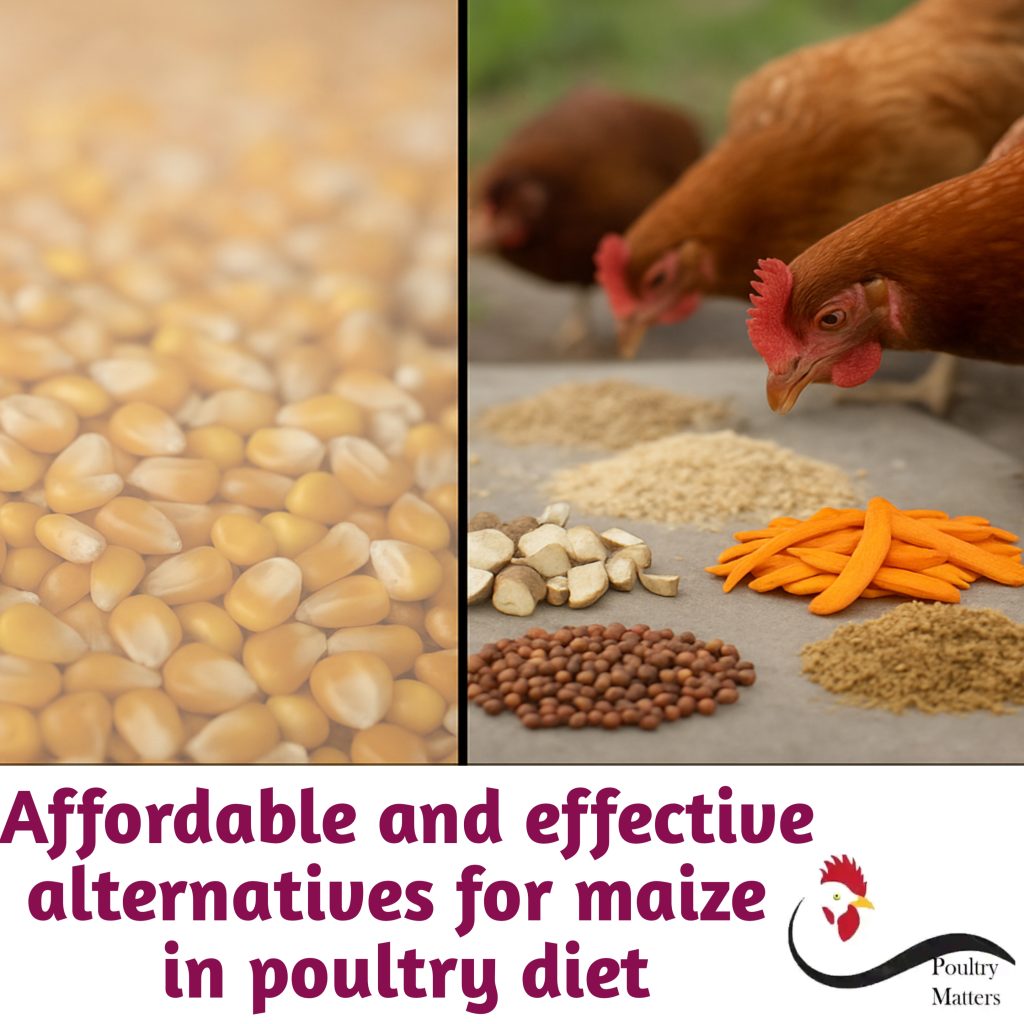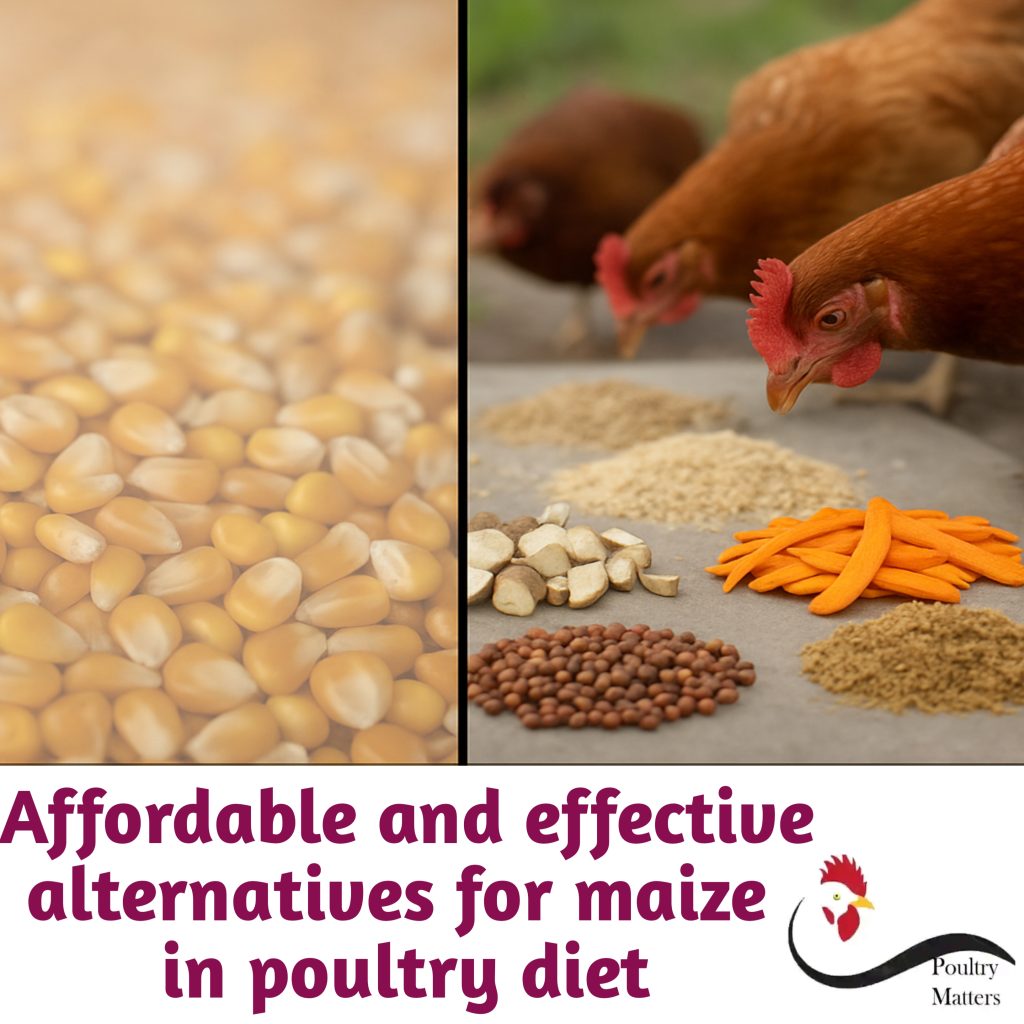Maize alternatives in poultry diet – what the poultry farmer should know
In poultry farming, feed remains the largest component of production cost (often accounting for 60%–70% of total poultry farm expenses). Maize (corn) has long served as the primary energy source in poultry diets due to its high carbohydrate content, palatability, and digestibility. However, challenges such as rising prices, seasonal shortages, competition with human consumption, and increased demand from other industries (like biofuel) have made maize increasingly expensive and less sustainable for many poultry farmers. As a result, exploring viable maize alternatives in poultry diet has become essential for poultry farmers seeking to reduce feed costs while maintaining bird performance and farm profitability.
Why consider alternatives for maize in poultry diet
Sourcing alternative material for maize in the poultry diet has become imperative for the poultry farmers (particularly for those who has the knowledge of formulating their poultry feed because of the following benefits –
Cost reduction –Using alternative(s) for feed formulation helps the farmer significantly reduce dependency on maize., consequently reduces expenses on the poultry feeding.
Sustainability – Also, the quick availability of viable maize alternatives helps to diversify the poultry feed ingredients. Thus, it helps the farmer optimize the use of resources earlier ignored.
Improve profitability – The significant reduction in feed cost with the integration of maize alternatives helps to improve the efficiency of the farm and consequently, the profit earning.
Key Maize Alternatives for Poultry Feed
Maize plays a crucial role in poultry feed as a primary source of energy. It contains high levels of carbohydrates, which provides the energy needed for growth, egg production, and daily activities of the birds. Maize is also relatively easy to digest and palatable, making it a preferred grain in feed formulations. Additionally, maize contains some vitamins such as vitamin A (in the form of beta-carotene) and small amounts of essential fatty acids. However, the associated challenges with price and seasonal shortages makes sourcing alternatives necessary. Below are some proven and commonly explored substitutes:
1. Sorghum (Guinea Corn
This provides a similar energy content (like maize) through its carbohydrates. Also, it supports the birds’ growth and productivity. Sorghum is drought-resistant and often more affordable, making it a cost-effective feed option.
Caution – Some varieties of guinea corn contain tannins, which can reduce nutrient absorption and feed efficiency. To maximize Sorghum’s benefits, as an alternative, the low-tannin sorghum varieties must be used. Furthermore, it is necessary to balanced sorghum with other protein and mineral-rich ingredients.
2. Millet –
This is rich in energy due to its carbohydrate content, it also provides moderate levels of protein, fiber, and essential minerals. Millet is easy to digest and has low levels of anti-nutritional factors compared to some other grains, making it suitable for young and adult birds.
Caution -Though , it can effectively replace part of the maize in feed formulations, it cannot fully match the energy content in maize, Therefore, it use can be optimized when combined with other nutrient-rich ingredients
3. Wheat and Wheat Offals (Bran) –
Wheat is a good source of energy and contains more protein than maize, making it suitable for both layers and broilers. However, it contains soluble non-starch polysaccharides (NSPs), which can reduce nutrient absorption unless enzymes are added to the feed.
Wheat bran, is a by-product of wheat milling. It is rich in fiber and moderate in protein. However, it is best used in limited quantities. It is more suitable for adult birds and can help reduce feed costs when properly balanced with other ingredients.
Caution – Limited quantity is recommended as it is high fiber levels. High fiber can lower energy availability, especially in younger birds.
b. For effectiveness, it must not exceed 30% of the feed content due to potential gut issues in chicks.
4. Sweet Potato Meal –
Sweet potato meal is made from dried and grounded sweet potato tubers. It is rich in carbohydrates making it a good energy source for poultry. It provides high energy, supports growth, and can improve feed variety. The meal is palatable and easy to digest when properly processed (dried and grounded).
Caution – It has low protein and essential amino acid content. Therefore, it must be combined with protein-rich ingredients like soybean meal.
b. Also, raw sweet potatoes contain anti-nutritional factors (like trypsin inhibitors and oxalates), so proper drying and grinding are essential before inclusion in feed.
5. Cassava –
It is a starchy root crop that can serve as an affordable alternative to maize in poultry feed. It provides high energy due to its rich carbohydrate content and can help reduce feed costs in regions where cassava is readily available.
Caution – However, cassava has very low protein and essential nutrients, so it must be balanced with protein-rich ingredients. Also, raw cassava contains cyanogenic glycosides, which can release toxic cyanide. Therefore, it must be properly processed—through drying, boiling, or fermentation—before being used in poultry diets.
NB – When used correctly, cassava can effectively replace a portion of maize without harming bird performance.
Important Considerations When Using Alternatives
When replacing maize with an alternative in the poultry diet, it is important to consider the nutritional value and potential limitation(s) of the substitute in view. Some factors are very fundamental in ensuring proper formulation and supplementation necessary for maintaining optimal growth, health and productivity of the birds. These essential factor to consider include –
- Nutritional Balance: Any replacement for maize must be carefully balanced with other ingredients to ensure the required protein, vitamins, and mineral levels are maintained.
- Anti-Nutritional Factors (ANFs): Some alternatives (e.g., cassava, sorghum) contain substances that can hinder digestion or affect performance. Proper processing is critical.
- Digestibility and Palatability: Ensure the birds accept the feed and can digest it efficiently for optimal productivity.
- Cost and Availability: Choose alternative ingredients that are affordable and locally available in your region.
- Enzyme Supplementation: Adding enzymes to the feed can improve nutrient utilization, especially when using high-fiber or less digestible ingredients.
Conclusion –
Substituting maize in poultry feed is not only possible but also beneficial when done correctly. Farmers must be informed and strategic—choosing alternatives based on availability, nutritional value, cost, and the type of poultry they raise (broilers, layers, or breeders).
Engaging with a poultry nutritionist or consultant can help you design balanced, cost-effective feed formulas that reduce dependence on maize while ensuring bird health and productivity are maintained. Take the next step—consult a nutritionist or start small-scale trials to discover which maize alternatives work best for your flock and your region.
We would love to hear from you – Let us know if you need help, you can also share your experience with us.

Read more on layer birds farming-
https://poultrygist.com.ng/2025/04/smart-ways-for-optimal-productivity-in-layers-farming/
Cheers.

